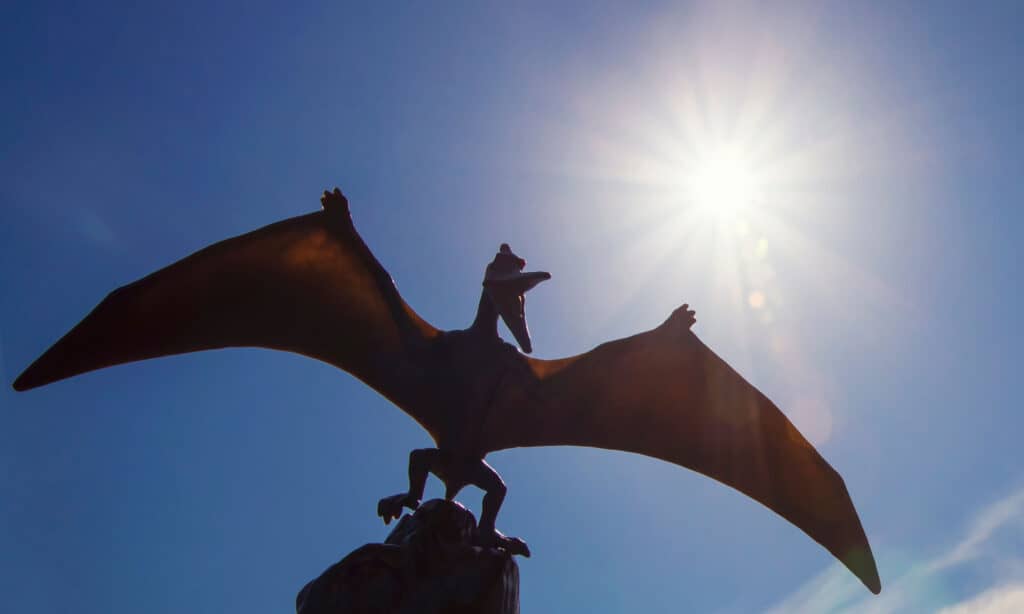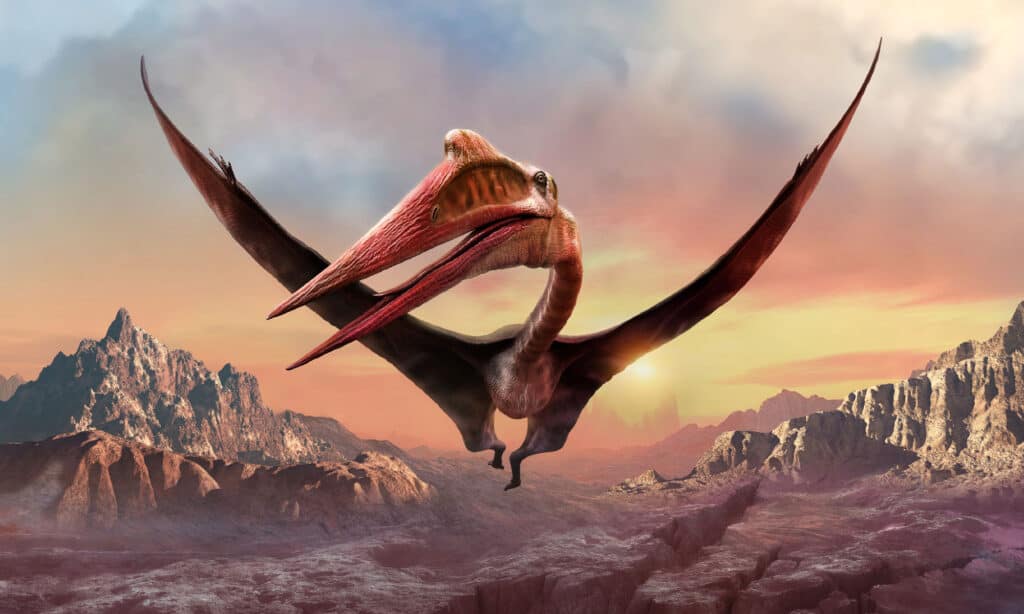Some believe that the dinosaurs were the only animals who existed during the “dinosaur era,” a millions-of-years period in Earth’s history. However, this is not the case. Pterosaurs, or flying reptiles, were common predators of this era as well. In fact, some of them were even more imposing than the dinosaurs! Many people refer to the Tyrannosaurus Rex as the ultimate dino predator. However, this may not necessarily be the case. There are pterosaurs that were bigger and potentially more powerful, like the Arambourgiania. Keep reading to learn more about the ‘titan wing’ predator that was big enough to tower over a T-Rex!
Basic Information About Arambourgiania

These huge pterosaurs were comparable to large predatory birds that exist now, such as shoebill storks and marabou storks.
©Marti Bug Catcher/Shutterstock.com
Arambourgiania was a pterosaur or flying reptile. This animal lived during the time of the dinosaurs. Arambourgiania lived in Asia during the Late Cretaceous period (72.1 million years ago to 66 million years ago). The first fossil of this flying reptile was discovered in 1987.
Arambourgiania lived in a marine environment and was a piscivore. This means that its diet consisted primarily of fish. However, they also hunted baby dinosaurs, lizards, and amphibians.
They are comparable to large predatory birds that exist now, such as shoebill storks and marabou storks. It is likely that these animals fed like storks, wading into the water for fish and grabbing small creatures from the ground.
This pterosaur had an extremely long neck, comparable to that of a giraffe. Scientists believe that its neck was about 9.8 feet, or 3 meters, long. This unusually long neck was about twice the length of other comparable pterosaurs. Arambourgiania also had a wingspan of 32.8 feet!
This massive flying reptile went extinct along with its fellow pterosaurs in the Cretaceous-Paleogene extinction event.
How Did Arambourgiania Fly?
Some might wonder how this animal could fly with such a long neck. The neck would have reached far in front of the wings, after all. However, it most likely compensated for this difficulty by adjusting its shoulders and wings.
It is unlikely that Arambourgiania constantly flapped its wings in order to stay in the air. This would have required an excessive amount of energy. Additionally, with its rigid neck, the animal wouldn’t have been extremely maneuverable. However, it is likely that this animal was able to fly for long stretches of time.
Some evidence suggests that Arambourgiania had a flight range long enough that it would have been able to travel all over the world. Giant fossils of various pterosaurs have been found on different continents, including Europe, Asia, and North America.
A second species of Arambourgiania was found in Pennsylvania long after the original bone was discovered. This suggests a much larger geographic range for Arambourgiania than was originally believed.
History of Arambourgiania’s Discovery
In the 1940s, scientists discovered a unique fossil bone in Jordan, alongside rocks from the Upper Cretaceous era. The bone was approximately 24 inches, or 62 centimeters, long. It was thin-walled, slender, and cylindrical in shape.
The bone suggests that the neck was not only long, but likely inflexible. This is unlike the long neck of a swan or heron, which is very flexible.
In 1959, Camille Arambourg of Paris (for whom the giant reptile was eventually named) initially called the newly discovered animal Titanopteryx philadelphiae. He believed that the bone was part of a giant pterosaur’s wing finger metacarpal.
In 1975, Douglas A. Lawson showed that the original bone was not a wing finger metacarpal at all. It was part of a neck vertebra.
Lev Nesov discovered that the genus name Titanopteryx already belonged to a fly. Thus, this animal needed a new name. Nesov and his colleagues gave the giant reptile its current name in 1987.
In the late 1990s, Eberhard Frey and David Martill sought to conduct a more thorough investigation of the bone. They learned that the original specimen had been sold in 1969 and was now the property of the University of Jordan. Once they located it, they realized the vertebra was incomplete. It was missing a posterior end. Due to this discovery, they came up with a new estimated length for the vertebra of 30.7 inches, or 78 centimeters. They believed that the bone was the fifth neck vertebra.
Arambourgiania vs. Quetzalcoatlus

Among the pterosaurs, Quetzalcoatlus is far better known than Arambourgiania.
©iStock.com/Warpaintcobra
In order to figure out roughly how large this animal was, Frey and Martill compared it to another pterosaur – Quetzalcoatlus. The neck vertebra of Quetzalcoatlus was 26 inches long, compared to 30.7 inches for Arambourgiania. The scale ratio was 1.18. They multiplied this number by the known wingspan of Quetzalcoatlus to reach the estimated wingspan of Arambourgiania.
However, smaller wingspans have been estimated for Arambourgiania based on more recent studies. Unfortunately, there is no way of knowing for sure unless scientists discover more fossil material for this creature.
Considering the length of the bone and the estimated wingspan, we now know that Arambourgiania was one of the largest pterosaurs. With its extremely long neck, it would have towered over the Tyrannosaurus Rex! In fact, this bird-like animal was actually the size of a small plane!
Among the pterosaurs, Quetzalcoatlus is far better known than Arambourgiania. Some say this is due to a common misconception that Quetzalcoatlus was a more impressive animal.
However, the likely reason is that we simply have more information on the former than the latter. Because scientists have found more fossils of the Quetzalcoatlus, it has enabled them to construct a more complete picture.
The remains of Arambourgiania are far from being complete. It is amazing that scientists were able to come up with a remarkable picture of this pterosaur with only one bone! There is so much that we do not know about this fascinating creature. However, the conclusions scientists have reached have made Arambourgiania look nothing less than incredibly impressive.
The photo featured at the top of this post is © 2,362 × 1,348 pixels, file size: 4.55 MB, MIME type: image/png – License / Original
Thank you for reading! Have some feedback for us? Contact the AZ Animals editorial team.






